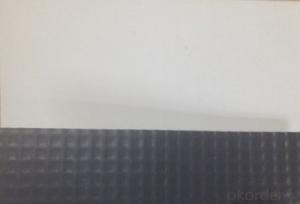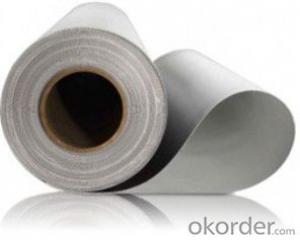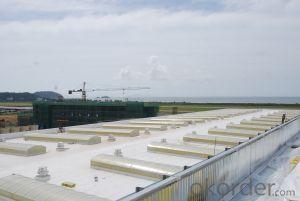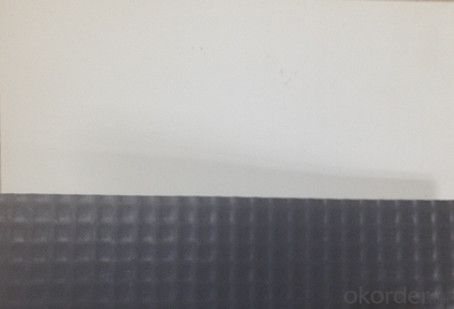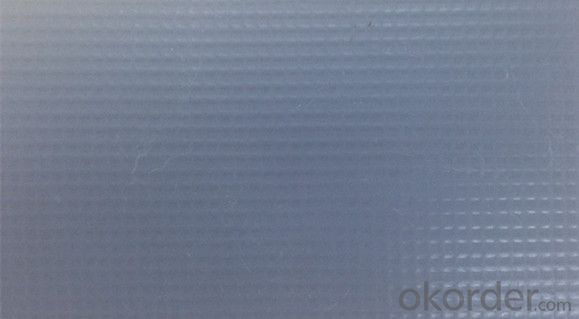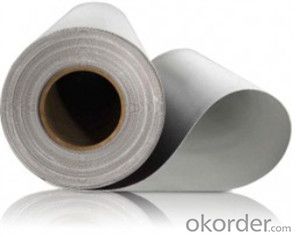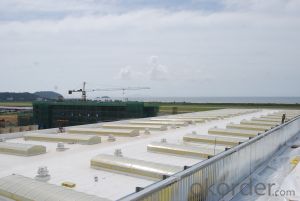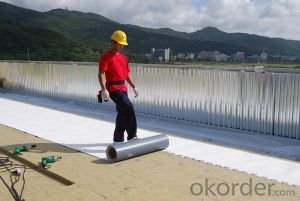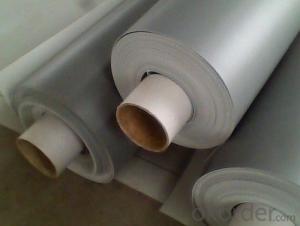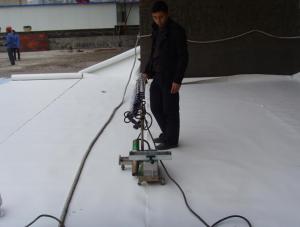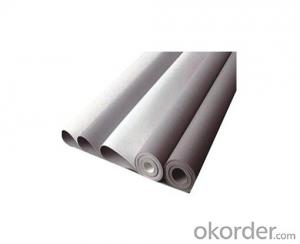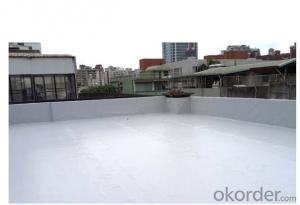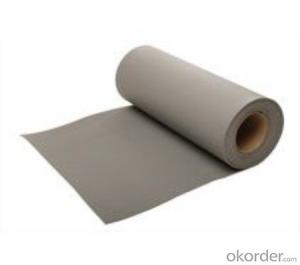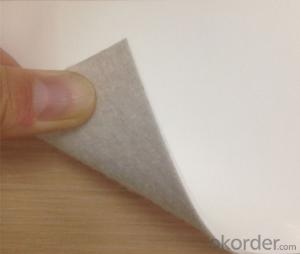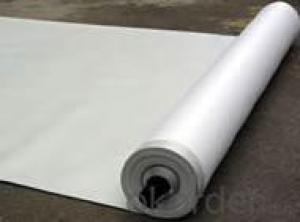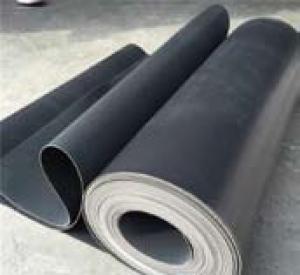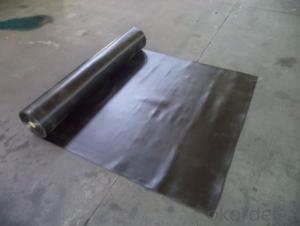TPO Waterproof Membrane with Polyester Mesh Reinforcement
- Loading Port:
- Shanghai
- Payment Terms:
- TT or LC
- Min Order Qty:
- 4000 m²
- Supply Capability:
- 400000 m²/month
OKorder Service Pledge
OKorder Financial Service
You Might Also Like
TPO Waterproof Membrane with Polyester Mesh Reinforcement
Product Profle
TPO membrane is a flexible Thermoplastic Polyolefin (FPO) roofing membrane made from the incorporation of a ethylene propylene rubber into a polypropylene matrix. The membrane is specifically formulated for long-term weather resistance without plasticizers.
We produce 4 types of TPO membrane to satisfy all the needs of different applications.
1.Polyester Fleece Backing Thermoplastic Polyolefin Waterproof Membrane
2.Polyester Mesh Reinforced Thermoplastic Polyolefin Waterproof Membrane
3. Homogeneous Thermoplastic Polyolefin Waterproof Membrane
4. Self adhesive TPO Membrane
TPO Waterproof Membrane with Polyester Mesh Reinforcement is a waterproofing sheet, consisting of thermoplastic polyolefin Compound resin materials as the base stock, reinforced with polyester mesh fabric. There have two kinds of thickness: 1.2mm and 1.5mm.
Advantages
● Weather resistance and durability; Excellent weld ability;
● No any crisp agents to prevent materials brittleness;
● Intermediate enhanced polyester mesh fabric to have high tensile strength, fatigue resistance and penetrating resistance suitable for mechanically attached roofing systems;
● Excellent the same high and low temperature resistance as rubber materials which can keep flexible at -50° C and keep mechanical strength in high temperature;
● Excellent chemical resistance to acids, bases, and restaurant exhaust emissions; Dimension stability;
● White-based light-color and smooth surface with high reflection, energy saving and anti-dust functions;
● Use heat welding for the seam areas to form a reliable seamless waterproof layer.
● Available in more than 9 colors.
Applications
● Various roofing waterproof projects, such as industrial and civil buildings,
● Mechanically attached waterproofing system.
Propoties
Item | Requirement | Test Method | ||
Thickness, min, mm | Sheet-overall | ≥1.0 | ASTM D6878 | |
Coating over fabric or scrim, weathering side only | ≥0.305 | ASTM D751 | ||
Breaking strength, min, N | ≥976 | ASTM D751 | ||
Elongation at reinforcement break, min, % | ≥15 | ASTM D751 | ||
Tearing strength,min, N | ≥245 | ASTM D751 | ||
Brittleness point, max, °C | ≤-40 | ASTM D2137 | ||
Ozone resistance | no cracks | ASTM D1149 | ||
Properties after heat aging | Breaking strength, % min | ≥90 | ASTM D573 | |
Elongation at reinforcement break, % min | ≥90 | ASTM D573 | ||
Tearing strength, % min | ≥60 | ASTM D573 | ||
Weight change (mass), max % | ≤±1 | ASTM D573 | ||
Linear dimensional change, max, % | ≤±1 | ASTM D1204 | ||
Water absorption, max, mass % | ≤±3.0 | ASTM D471 | ||
Factory seam strength, min, N | ≥290 | ASTM D751 | ||
Weather resistance | Visual inspection | - | ||
Packaging
Thickness | Roll Size | Rolls / Wooden Crate | Wooden Crate / 20’ Container |
1.2 mm | 15 m2 | 25 | 20~25 |
20 m2 | 25 | ||
30 m2 | 25 | ||
1.5 mm | 15 m2 | 25 | |
20 m2 | 25 | ||
30 m2 | 23 |
Above quantities are indicative only. We can produce it according to your demands.
Storage
TPO material should be stored in well-ventilated place and avoid being exposed to the sun or rain. The temperature in stored places can not be higher than 45° C. It only can be put horizontally in five-level. It has to be avoided acid, alkali, oil and organic solvents. The shelf life is 1 year.
Transportation
TPO material should avoid inclination or lateral drift during transportation. When necessary, covering with felted fabric.
Application System
We not only provides TPO waterproofing membrane, but also dedicates to integrated roofing systems. TPO single ply roofing waterproof system includes mechanically attached roofing system, fully adhered roofing system and ballasted roofing system.
Application Methods
● For Mechanically Attached Roofing System
Before application, spread TPO membranes on substrate in advance. Install TPO membranes perpendicular to steel deck ribs on the substrate without distortions according to the flange. The overlapping width is 120 mm. The minimum overlapping distance of membrane short side direction is 50 mm. Fasteners are installed according to designed position. Hot-air welding is adopted for laps with 40 mm welding width.
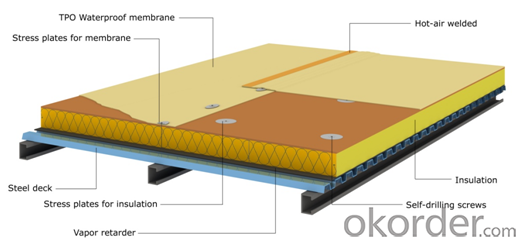
Attentions
● TPO membranes reflect heat and light, wearing protective clothing (long-sleeved shirt, long-barreled trousers), and wearing a filter to protect the skin and eyes from UV-induced damage.
● Security measures for roof perimeter are necessary when application. Sheet surface is slippery when wet, taking care to avoid slide.
● Sealants and adhesives are flammable containing solvents. They will be dangerous when exposure to heat, even have the possibility to catch fire and explode.
● Sealants, adhesives, cleaners should be avoided contacting with skin and eyes.
● No smoking during application.
FAQ
1. What’s your production ability of TPO membrane per year?
We own the largest EPDM production line in China. Our product ability of TPO membrane reaches 500million square meters.
2. How's your products quality?
Our TPO is with the top quality at home and abroad. Our quality is much higher than Chinese standard, they can satisfy the certification of CE, GOST-R, FM.
3. What's the service life of your TPO membrane?
The service life of our TPO membrane is more than 50 years.
4.What's your MOQ?
Our MOQ is 4000M2.
5. Can you provide free of charge samples for testing quality?
Yes, we’re very glad to send you free of charge samples for checking. You just need to pay for the freight cost.
6. How do you protect TPO membrane in transportation?
We package TPO rolls by PE bag, then 20~25 rolls will be packed into one big wooden crate.
7. Can you customize TPO membrane?
Yes, we’re very glad to customize TPO membrane according to your requirement. We can do more than 9 colors, and customize the thickness and width according to your requirement.
Photos
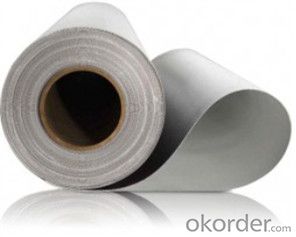
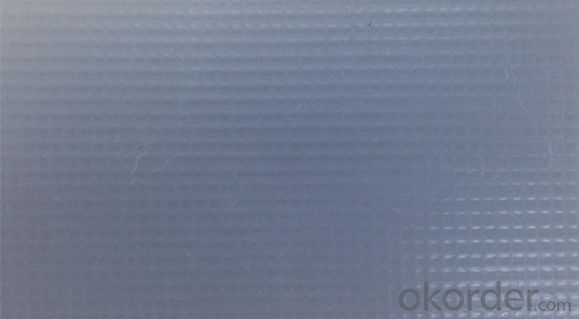
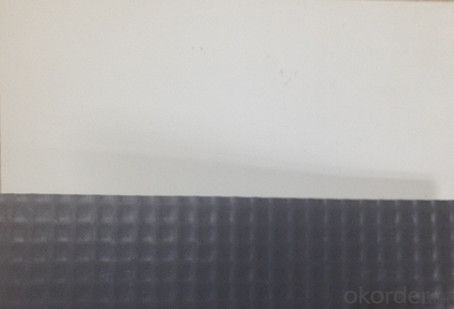
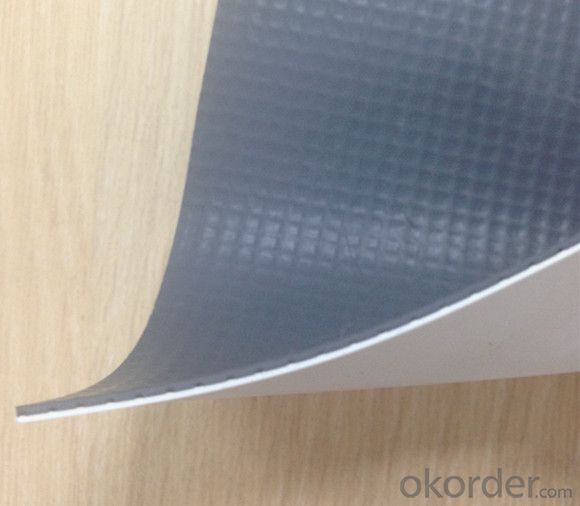
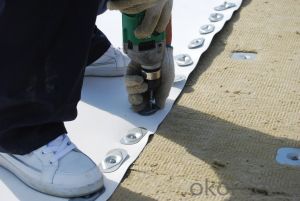
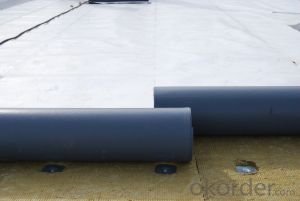

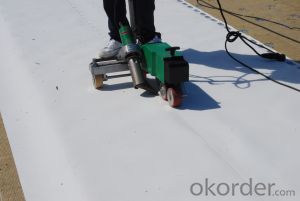
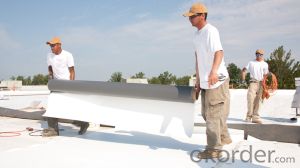
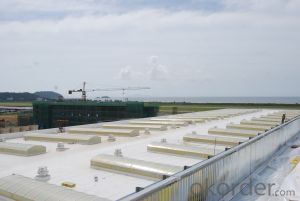
- Q: Does a waterproofing membrane require any special cleaning or maintenance procedures?
- Yes, a waterproofing membrane does require special cleaning and maintenance procedures. While it is designed to be resistant to water and other elements, regular maintenance is important to ensure its longevity and effectiveness. The specific cleaning and maintenance procedures may vary depending on the type of waterproofing membrane used, but generally, it is recommended to keep the membrane clean and free from debris, such as leaves, dirt, or other foreign objects. This can be done by regularly sweeping or gently washing the surface with water and a mild detergent if necessary. Additionally, it is important to inspect the membrane regularly for any signs of damage, such as tears, cracks, or loose seams. Any such issues should be addressed promptly to prevent water infiltration and further damage. In some cases, specialized cleaning products or treatments may be recommended by the manufacturer or installer of the waterproofing membrane. It is important to follow their guidelines and recommendations to ensure the best care and maintenance for the specific membrane used. Overall, regular cleaning and maintenance of a waterproofing membrane will help to extend its lifespan and ensure its continued effectiveness in protecting the underlying structure from water damage.
- Q: Can a waterproofing membrane be used on tunnels with historical significance?
- Yes, a waterproofing membrane can be used on tunnels with historical significance. The membrane can help protect the tunnel from water damage and prevent further deterioration, ensuring the preservation of its historical significance.
- Q: Can a waterproofing membrane be used for a podium deck?
- Yes, a waterproofing membrane can be used for a podium deck. A waterproofing membrane is a common solution for protecting structures from water damage, including podium decks. It helps to prevent water infiltration and can ensure the longevity and durability of the deck.
- Q: Can a waterproofing membrane be used on brick walls?
- Yes, a waterproofing membrane can be used on brick walls. It helps to prevent water penetration and protects the bricks from moisture damage.
- Q: Can a waterproofing membrane be used for balconies or decks?
- Balconies or decks can indeed benefit from the use of waterproofing membranes. These specialized membranes are designed to safeguard surfaces against water damage, making them an excellent option for outdoor areas that are continuously exposed to the elements. Typically crafted from durable materials like rubber or PVC, these membranes are applied directly onto the balcony or deck surface. They form a protective barrier that prevents water from permeating the underlying structure, thus prolonging the lifespan of the balcony or deck and preventing issues such as rot or mold. Moreover, waterproofing membranes offer additional safeguards against UV rays, chemicals, and foot traffic, making them a dependable choice for enhancing the resilience and longevity of balconies and decks.
- Q: Does a waterproofing membrane require any special precautions during storage?
- Yes, a waterproofing membrane requires special precautions during storage. It should be stored in a dry, cool, and well-ventilated area, away from direct sunlight and extreme temperatures. It should be kept in its original packaging or wrapped properly to prevent any damage or exposure to moisture. Additionally, it is important to avoid storing it near any sharp objects or chemicals that could potentially cause punctures or degradation of the membrane. Regular inspection and rotation of stock is also recommended to ensure the membrane remains in optimum condition.
- Q: How does a waterproofing membrane handle exposure to high temperatures?
- The ability of a waterproofing membrane to withstand high temperatures relies on its composition and quality. These membranes are typically made from durable materials like bitumen, EPDM, or PVC, which have high melting points and can resist heat. These materials are carefully selected to ensure that the membrane remains intact and effective even when exposed to elevated temperatures. The resistance of high-quality waterproofing membranes to heat is enhanced through the use of additives and fillers during manufacturing. These additives help the membrane maintain its integrity, preventing it from softening, melting, or becoming brittle under high temperature conditions. Additionally, the successful installation of the waterproofing membrane is crucial to its ability to handle high temperatures. Proper installation techniques, such as ensuring adequate adhesion and seam sealing, are essential for maintaining the membrane's effectiveness and preventing any potential damage caused by heat exposure. To summarize, waterproofing membranes are specifically engineered to withstand high temperatures. Their composition, quality, and installation techniques all contribute to their ability to resist heat without deteriorating or losing their waterproofing properties.
- Q: Can a waterproofing membrane be used on precast brick block surfaces?
- Yes, a waterproofing membrane can be used on precast brick block surfaces. The membrane acts as a protective barrier, preventing water from seeping into the bricks and causing damage such as cracks, efflorescence, or mold growth. It is important to choose a waterproofing membrane that is specifically designed for use on masonry surfaces, as these membranes are formulated to adhere to the unique properties of brick and block materials. Additionally, proper surface preparation and application techniques should be followed to ensure the effectiveness of the waterproofing membrane.
- Q: Can a waterproofing membrane be used on insulation surfaces?
- Yes, a waterproofing membrane can be used on insulation surfaces. In fact, it is often recommended to install a waterproofing membrane over insulation to provide an additional layer of protection against water infiltration. This is especially important in areas where moisture is a concern, such as basements, roofs, or exterior walls. The waterproofing membrane acts as a barrier, preventing water from seeping into the insulation and causing damage. It also helps to maintain the integrity and effectiveness of the insulation by keeping it dry. Additionally, some waterproofing membranes have the added benefit of improving the energy efficiency of the insulation by reducing air leakage and heat transfer. Overall, using a waterproofing membrane on insulation surfaces is a smart and practical solution to protect your building or home from water damage.
- Q: How long does it take for a waterproofing membrane to cure?
- The curing time for a waterproofing membrane varies depending on the specific product and environmental conditions, but generally, it takes around 24 to 48 hours for a waterproofing membrane to fully cure.
Send your message to us
TPO Waterproof Membrane with Polyester Mesh Reinforcement
- Loading Port:
- Shanghai
- Payment Terms:
- TT or LC
- Min Order Qty:
- 4000 m²
- Supply Capability:
- 400000 m²/month
OKorder Service Pledge
OKorder Financial Service
Similar products
Hot products
Hot Searches
Related keywords
